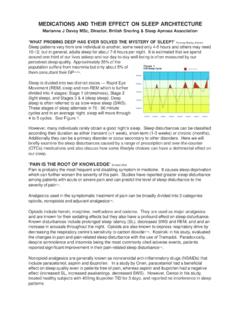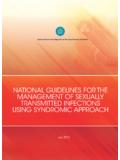Transcription of Training the 21st Century PoliceOfficer
1 Prepared for the Los Angeles Police DepartmentTraining the 21st CenturyRedefining Police Professionalism for theLos Angeles Police DepartmentRussell W. GlennBarbara R. PanitchDionne Barnes-ProbyElizabeth WilliamsJohn ChristianMatthew W. LewisScott GerwehrDavid W. BrannanPublic Safety and JusticeRPolice Officer This report was prepared for the City of Los Angeles and the Los Angeles Police Department by RAND Public Safety and Justice, 1700 Main Street, Box 2138, Santa Monica, CA 90407-2138. RAND is a nonprofit institution that helps improve policy and decision-making through research and analysis.
2 RAND is a registered trademark. RAND s publications do not necessarily reflect the opinions or policies of its research sponsors. Published 2003 by RAND Cover design by Peter Soriano ISBN: 0-8330-3468-5 Copyright 2003 City of Los Angeles All rights reserved under copyright and international laws. This is a public document pursuant to the California Public Records Act, and is available via the Internet at This document may be reproduced solely for personal, non-commercial and not-for-profit uses, but may not otherwise be copied, reproduced, modified, altered, distributed, displayed, or used by anyone without prior written consent from the City of Los Angeles (via the Los Angeles City Attorney s Office -- Intellectual Property Counsel).
3 IiiPREFACEOn June 15, 2001, the City of Los Angeles signed a consent decreewith the United States Department of Justice. The consent decree isessentially a settlement agreement that aims to promote police in-tegrity and prevent conduct that deprives persons of rights, privi-leges, or immunities secured or protected by the Constitution or lawsof the United States. Areas for remediation are identified and expe-ditious implementation of corrective measures is required. Thisproject is the result of the mandate of one paragraph in the decreethat requires an independent examination of police Training in theareas of use of force, search and seizure, arrest procedures, com-munity policing, and diversity awareness.
4 RAND conducted thisstudy over a nine-month period (July 1, 2002 March 31, 2003).This study will be of interest to Los Angeles City residents and thosein the Los Angeles City government. It also has national applicationfor the field of police project was funded by the City of Los Angeles on behalf of theLos Angeles Police PUBLIC SAFETY AND JUSTICEThis study was conducted within RAND s Public Safety and Justiceunit. RAND Public Safety and Justice conducts research and analysisthat helps inform policymakers and communities in the areas ofpublic safety, including law enforcement, terrorism preparedness,immigration, emergency response and management, and naturaldisasters; criminal justice, including sentencing and corrections pol-ivTraining the 21st Century Police Officericy, firearms, and community violence; and drug policy, which fo-cuses on problems related to illegal drugs and substance abuse.
5 In-quiries regarding RAND Public Safety and Justice may be directed toJack RileyRAND Public Safety and Justice1700 Main StreetSanta Monica, CA xixChapter OneBACKGROUND AND 1 Setting the 3 The Foundation s Cornerstone: A Coherent Approach 3 Chapter Two: Law Enforcement Professionalism andthe 4 Chapter Three: 6 Chapter Four: The Police Responsibility toCommunity-Oriented Policing in a Diverse 6 Chapter Five: Developing Police 7 Research Methodology and Data 8 Literature 9 Case 10 Written Curriculum Review and 11 Police Focus 18viTraining the 21st Century Police OfficerEstablish an LAPD Lessons-Learned 18 Introduce and Maintain Consistently High QualityThroughout Every Aspect of LAPD 19 Restructure the LAPD Training Group to Allow theCentralization of Planning; Instructor Qualification,Evaluation, and Learning Retention.
6 And MoreEfficient Use of 19 Integrate Elements of Community-Oriented Policingand Diversity Awareness Training ModelsThroughout LAPD 20 Develop Training on Use of Force, Search and Seizure,and Arrest Procedures That Meets Current Standardsof 21 Chapter TwoTHE LUSTER IN THE BADGE: LAW ENFORCEMENTPROFESSIONALISM AND THE 23 What Does It Mean to Serve with the LAPD?.. 24 What Is a Profession?.. 28Is Law Enforcement a Profession?.. 29 Can the LAPD Be a Professional Force?.. 33 Getting There from 34 Chapter 37 Every Cop a Teacher: A Call for Creating an EffectiveLessons-Learned 39 Lessons Learned and What They Offer the 39 Developing Lessons 42 Identifying and Distributing Lessons 43 Getting Lessons to the 45 Concluding 49 Transforming John Doe into an LAPD Professional.
7 Building Excellence into the Police 49 The Backdrop for Training at the 49 ContentsviiTraining the Professional Police 50 Educational 53 Curriculum 56 Models of Teaching Instructor Development 59 The Case for Evaluating Training 62 Current LAPD Training Organization 66 Guiding Principles for the Restructuring of the 69 Training Organization Structure 74 Training Organization 78 Chapter FourTHE POLICE RESPONSIBILITY TO COMMUNITY-ORIENTED POLICING IN A DIVERSE 91 The Redefined Police Professional Has a Responsibility toPublic 91 Community Policing and Its Development inLos 93 The Importance of Diversity 98 What Is Needed for Community Policing to Succeed?
8 100 Training for Community 103 Key Components of Community Policing 104 Points of 116 Chapter FiveDEVELOPING POLICE 119 Use of Force, Arrest Procedures, and Search and SeizureAs Issues of 122 Contextualize the 125 Integrate Key Topics Throughout the 127 Build the 134 Conduct a Thorough 139 Conclusion and Specific 140 Chapter 147 Overarching 148 Primary 148viiiTraining the 21st Century Police OfficerAppendixA. PROJECT TEAM 153B. RAND Training DOCUMENT REVIEW ANDCLASSROOM OBSERVATION 155C. INDIVIDUAL INTERVIEW 163D.
9 INDIVIDUAL INTERVIEW ANGELES POLICE DEPARTMENT CORE ANGELES POLICE DEPARTMENT 177G. LAPD ORGANIZATION 183H. SUMMARY OF ORGANIZATION MANAGEMENT SYSTEMS: TOOLS TOINCREASE THE EFFECTIVENESS OF LAPD STUDIES A BRIEF COMPENDIUM OF POLICETRAINING INNOVATIVE 205K. COMMUNICATIONS OF Training 229M. SUMMARY OF Training LAPD Training Organization 1: Proposed LAPD Training 2: Proposed LAPD Training LAPD Training Organization 1: Proposed LAPD Training 2: Proposed LAPD Training 186 Observations As a Percentage of theWritten Materials Focus Methods Employed During LAPD Angeles Population by Assessment Ratings and Comments on Training 230 xiiiSUMMARYThis book summarizes a nine-month study conducted by RAND forthe Los Angeles Police Department (LAPD, also hereafter referred toas the Department).
10 The City of Los Angeles entered into a consentdecree with the Department of Justice. The objective of thisbook is to provide analyses and recommendations to assist the LAPDin meeting the requirements outlined in paragraph 133 of this de-cree, ultimately enabling the LAPD to better serve the interests of thepeople of Los Angeles through improved Training in five critical areas are use of force, search and seizure, arrest procedures,community policing, and diversity in our investigation, it became apparent that many of the De-partment s Training problems share a common foundation.











